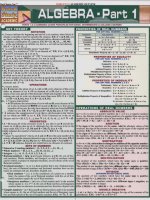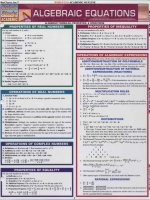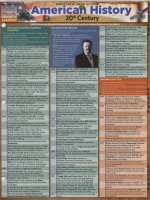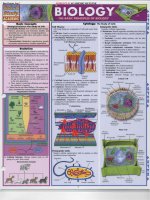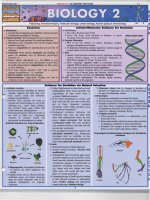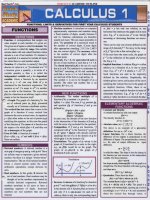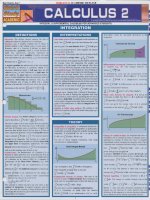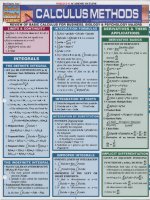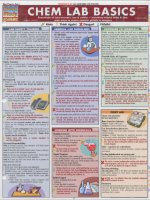Quick study computer UNIX 600dpi
Bạn đang xem bản rút gọn của tài liệu. Xem và tải ngay bản đầy đủ của tài liệu tại đây (12.63 MB, 5 trang )
always remained a research oriented tool under the
The UNIX operating system is a multi-user com
Berkeley umbrella until its last releasc (BSD 4.4) in the
puting environment designed to provide access to a
mid 90's. Companies who used UNIX as the primary oper
range of computer applications, tools and utilities to
ating system for their high-end servers and workstations
the users of the system. 11 was designed and developed
licensed earlier releases of BSD and System V
by Bell Laboratories in the late 60 's and 70's for scien
tists at Bell Labs to help with research , such as writing
The Internet explosion has provided an immense col
and publishing technical papers, storing and manipu
laborative environment, which has produced a widely
popular UNIX clone (in that it was not based on the orig
lating data, communicating ideas and working with fel
inal UNIX source code) called Linux. Linux provides thc
low colleagues.
same functionality of BSD or SYSV UNIX, but is a com
Universities and colleges obtained UNIX from Bcll
pletely new design tl'om the ground up which runs on the
Labs for research into operating system design. In par
Intel x86 platforms, as well as other hardware architec
ticular, one university - UC Berkeley, made a variety
tures. Other variants of the original BSD UNIX inelude
ofimprovemcnts and changes to UNIX and released its
FreeBSD, OpenBSD and NetBSD.
own version under the Berkeley Software Distribution
(BSD) label. Bell Labs also . - - - - - - - - - - - - - - - - - - - - - - - - - - - - -
improved its own version of • UNIX Applications. X Window System, Compilers, Mail, Word Processing.
UNIX under the Systcm V • UNIX Tools. Bourne/c/KSH Shell, Utilities (vi, tron; man, Ip, who, sort).
name. Each variant provided • UNIX Kernel. Device Drivers, Resource / Process ! Memory Management.
Hardware. CPU, Memory, Modem, Hard Drives, Network , Video, I/O.
similar functionality, but BSD
LOGGING IN/OUT
Logging In
Every UNIX user has a UNIX login username and
password. This allows UNIX to keep track of the dit~
ferent people and provide a separate working space for
each person within the same system. Users can obtain
their UNIX uscrname and password from their system
administrator. UNIX is a case-scnsitive environment,
so take careful note of the upper and lowercase in the
username and password.
Once the uscrname and password is obtained, enter
them at the login prompt:
Login jsmith
Password: florida
Welcome to SunOS 4.1.4 (GENERIC Kernel)
$
not usc common words; instead usc a combination of
numbers and letters. A good example is to usc the first let
ters from a verse of a t~lVorite poem, followed by two
numerals. For example: Twinkle, 7il'inkle, Lillie Star
becomes ttls4:!.
It is possible to change the password with the passwd
command:
$ passwd
Enter your old password: florida
Enter your new password: ttls42
Reenter your new password: ttls42
Password changed.
$
Logging out
Changing the password
Since UNIX is a multi-user system, it is very important
to log out of the session aner the work is completed. Thi s
releases the terminal back to the login: prompt so that the
next user may login. Logging out can be accomplished by
typing "exit" at the shell prompt:
$ exit
After logging in, change the password to something
other than what was initially given. It is a good idea to
Depending on the shell, it is possible to use "logout" or
""D" (Colltrol-D).
The "$" is the UNIX Shell prompt. It may vary
depending on the specific system (the most common
variant is "%"). The Shell is where the work will be
completed for most of the session.
..................
~
Once logged into the account, the most common
tasks will be reading e-mail, editing, running applica
tions, writing and compiling programs, using databas
es, etc. All of these involve working with files. UNIX
uses a hierarchical system to store and retrieve files
using what arc known as directories. The figure below
shows an example of how typical UNIX systems direc
tories are arranged.
/
I
home
I
lib
I
usr
I
I
I
tmp
I
I
etc
I
bin
I
dsk
I
lp
I
I
bin local sbin
I
dev
I
log
I
I
I
mail spool adm
I
proc
The tree-like arrangement starts from the root, " I,"
directory on downwards. Each branch (i.e., directory)
can have sub-branches (sub-directories). Finally, a
directory can have individual files (similar to leaves on
branches). Thc forward slash (or divide) sign, "/," is used
to delimit each sub-directory. The combination of the
directories and files comprise the UNIX file system.
Directories
When logging in to a UNIX system occurs, the user
is lefl in what is known as the HOME directory, which
is usually somewhere underneath several levels of sub
directories all starting from the root, "I," directory.
With this pwd command, the user can tell where the
homc directory is located.
$ pwd
/home/staff/jsmith
$
/bin/ ksh
$
Instructions to run program s are run from the com
Illand line prompt of the shell. The co mmand syntax
takes the Ii) Ilowing common lorm:
command /optfolls//param eters/
The optiolls control how the co mmand executes and
arc usually preceded with the dash si gn, "-." The
parameter.~ (al so known as arguments ) are the data that
the command will be processin g. T hese can be num
bers , words or even filenam es:
• ps -ef - List all the proccssc s running o n the cur
rent system.
• wc -I letc/passwd - Count the number of lines
in the file namcd /ctc/pa sswd.
• echo $SHELL - Print the valuc o f the S HELL
environment variabl e.
The semi-colon, " ;" can be used to spec ify multiple
commands on one linc:
Is -I : pwd ; who
THE UNIX FILESYSTEM
In the previous box, the home directory of the user is
the sub-directory named "jsmith," which also happens to
be the login user id (this is normal UNIX convention).
The "jsmith" sub-directory is underneath the "staff" sub
directory, which is underneath the "home" sub-directory,
which itself is underneath the top-most " root" directory.
All files that belong to "jsmith" should be created inside
/home/staff/jsmith.
Files
I
var proc
Shells provide a command line interface to the
UNIX environment and wrap access to fil es, applica
tions and other tools (thus, the term "shcll " ). Shells are
also known as command interpreters, since they accept
commands from the uscr and interpret them to the
UNIX systcm. The shell allows the usc r 10 create sim
ple commands to execute certain tasks or devel op com
plex scripts, which can be enti re program s within
themselves. Depending on the systcm administrator,
the user may have one of the fo ll owing shell s:
• Ibin/sh - Bourne Shell - The most common shell
available on all UNIX system s.
• Ibin/csh - C Shell- - An other popular shell
designed with shell programming in mind.
• Ibinlksh - Korn Shell - An advanced version of
the Bourne Shell , which incorporated many of the
featurcs of the C Sh ell.
• Ibinlbash - Bourne Again Shell - A free ly avail
able shell similar to ksh but with mo re advanced fea
tures. Availabl e from http ://www.gnu. org .
• Ibinttcsh - l~lg C Shell Another freely available
shell
similar
to
csh.
Availabl e
from
/>To find out which shell is in usc, type thc follow ing
command aner logging in:
$ echo $SHELL
A file is a collection of data, such as an e-mail message ,
information fl'om a database, images, source code, etc.
The files reside underneath the user's HOME directory.
UNIX allows creation of sub-directories so that the user
can arrange the data in an orderly f~lshion for faster
retrieval (it is much easier to have five sub-directories with
10 files in each of them than one sub-directory with 50
files). When referencing files, do so in one of three ways:
• Simple. Just the filename, which needs to reside in
the current directory.
Example: taxes. txt
• Absolute. Specify the entire path to a file starting
from the root "/" directory.
Example: Ihollle/staj!!jslII ithlji /lallce/taxes. fKf
• Relative. Specify the path to a file relative to the cur
rent sub-directory.
EXllmple:.jinallce!taxes.txt
Working with Directories
UNIX provides the ability to move swiftly within the
UNIX filcsystem:
• pwd - Print the current working directory (CWD).
• cd
• cd
• cd
• cd
• cd
- Return 10 HO ME directory.
dirname - Change into the directory named di!:
I - Change into the root directory.
.. - Change one directory up.
. .1.. - Change two directories up from the current
directory.
• cd lusr/local - Change into thc dircctory named
/usr!local (absolute path).
• cd ..ltmp - Change into the tmp directory, which
exists one Icvel higher.
Creating and removing directories arc done with two
basic commands:
• mkdir dirname - C reate a directory nam cd
dirname in the current directory.
• rmdir dirname - Remove th e directory named
dirname in the current directory. The directory mu st
be empty (i.e., no sub-directories or fil es within).
Listing Files and Directories
The Is command is used to list the cont ents o f direc
tories and the files within them. It can take a vari ety of
options, as shown below:
• Is - List contents o f the current directory (only shows
the names of files and directories).
• Is -a - List all files in the current directory including
those that begin with "." (hidden fil es).
• Is -b . Force printing of non-printab le characters
using octal (base-8) notation. Thi s is use ful when
there are hidden characters in fi lenames.
• Is -F - Appcnd a slash, "/," after directory, an asteri sk,
"* ," after each executable file (including shell scripts)
and an at-sign , " @," a ncr each symboli c link.
THE UNIX FILE SYSTEM continued
REDIRECTION
• Is -I - List contents of currcnt directory in long format (See: below).
• Is -t - List contents sorted by time-stamp instead of alphabetically.
The ability to redirect the input and output of an application is one of the most
powerful features of the UNIX shells. Using redirection, it is poss ible to build com
plex commands by linking thc output of one program to the input of another; or, to
save the output of one program to a file so that it can be processcd later by anothcr
program. All UNIX shells provide the following basic rcdirection capabilities:
The long listing (Is - I) is the most common method of invocation of the Is command.
It includes the file permission, number of links, owner, group, size and time of last mod
ification for each file listed. For example:
Redirection
$ Is -al
Meaning
cOlI/malld > file
drwx--x--x
drwxr-xr-x
-rw-r--r--rw-r--r--rwxr-xr-x
-rw-r--r-drwxr-x---rwxr-xr-x
drwx--x--x
-rw-r--r-drwxr-x---
10
13
1
1
1
1
2
1
7
1
2
jSmith
root
jsmith
jsmith
jsmith
jsmith
jsmith
jsmith
jsmith
jsmith
jsmith
staff
staff
staff
staff
staff
staff
staff
staff
staff
staff
staff
1024
512
2650
10327
648
226
512
1320050
1024
5877
512
Send thc output of col/llllalld tojile instead of
sending it to the screcn.
cOlI/malld
instead of reading trom the keyboard.
commalld » file
Append the output of cOlI/lI/al/d to.file.
cOl/lI/wlldI I command2
Send the output of cOl/lIl/ol/d I as input to com
mOl/d2 (piping).
In addition, each shell provides additional redirection of standard error and stan
dard output:
May 24 20:58
May 14 15:54 ..
Nov 9 1998 .newsrc
Dec 14 11 :05 .pinerc
Mar 3 16:04 .profile
Jan 8 1997 .sig
May 18 11:33 finance
Jan 8 14:35 1ynx
May 621 :20 public_html
May 18 11:34 students.txt
May 18 11:33 work
Bourne/KornlBash Shells
Redirection
Meaning
command I> filel 2> file2
$
Send the standard output to fi Ie I and standard
error to file2 or command.
Combine the standard error to standard output.
Same as above except redirect the combined out
put to file.
command 2>& I
command 2>& I > file
The first column represents the permissions for each file or directory and is
explained in detail below. The second column is the number of links, which is very
rarely used in day-to-day sessions. The third column is the owner of the file/directory
followed by the group in the fourth column. The fifth column is the file size in bytes.
The sixth, seventh, and eighth columns show the time of last modification (month, day,
hour and minute, if in thc current year or month, day and year for any previous years).
The last column is the actual name of' the file/directory.
C Shell
Redirection
Meaning
command >& filel
Combinc standard error and standard output and
sent to fi Ie I.
Same as above except append to fi Ie I instead of
overwriting it.
command 2>& I > fil e I
ACCESS PERMISSIONS
Numeric - chmod mode file-list t1irec((JlJ'-list
Examples:
$ chmod 755 hello.pI
$ Is -1 hello.pI
Permissions allow the owner of the file/directOly to specity who has access to the file or
directory and how they can use it. There arc three basic types of permissions:
• Read. Allows user to view the co ntents of a file (for example, with an editor). On
directories, read access allows you to list the directory contents. Read access is
noted with the "r" letter in the permissions column.
• Write . Allows uscr to modify the contents ofa rile but not de lete or rename it. On
directories, write access a llows the uscI' to create new files and delete or rename
ex isting fi les. Write access is noted with the "w" letter in the permissions column.
• Execute. Allows user to run the file as a program. This requires that the file be
either a compiled program or a shell script (if not, unexpected errors will occur).
On dire.ctories, execute access a llows the user to list the contcnts ofthc directory.
Execute access is noted with the "x" leller in the permissions column.
In addition to the above three permissions, there are a few more permission sellings
available, but vcry seldom used. The manual page on chmod( I) describes them in detail.
-rwxr-xr-x 1
-rw-r--r-
1
jsmith
---x--x--x 1
smith
jsmith
-r-x--x-- x
5 11
May 2821 :08 final. sh
staff
5 12
May 282 1:08 p ublic_html
owner of file (user)
group which file belongs to
everyonc cl se (others )
combination of u.g,o (all)
Operation Meaning
+ Add permi ss ion for the specificd USCI' or g roup or othe rs.
Delete permi ssion for the specified uscr or group 01' others.
Set permi ssion for the specified uSCI' or group or others.
Finally, the permi ssion itse lf is a letter (or combination of letters) as follow s:
Letter
w
x
Meaning
Reacl Permission.
Write Permission.
Execute Permi ssion.
Examples:
$ 15-1
-rwxr-xr-x
-rw-r--r-
---x--x--x
drwx--x--x
Examples:
700
407
The operation parameter can be an add ition, subtracti on or assignmcnt of the pcrmiss ion:
None (---)
Execute (-- x)
Write (-w-)
Write & Execute (-wx)
Read (1'--)
Read & Execute (r-x)
Read & Write (rw-)
Read, Write & Execute (rwx)
-rwx------
staff
Meaning
u
g
o
a
Literal Meaning
755
May 282 1:08 re a dme. txt
The who parameter can be a letter (or combination of letters) as foll ows :
Letter
Numeric
Representation
644
-rw-r--r--
5571
Symbolic - chmod w/r%peratioll/permissiOJI.tiIelist t1irecto/JI-list
The first character denotes whcther the object is a file, "-," link, " I," or a directo
ry, "d." The next three characters denote the owner access to the file/directory
(read/write/execute). The next three characters denote the group access to the
file/directory. Finally, the last three characters denote access to the file for everyone
else. When tryi ng to access a fi Ie, UN I X first checks to see if the user is the owner
of the file and uses the owner permi ssions, if true. Ifnot, it checks if the user belongs
to the same group as the file and uses the group permissions, if true. Ifnot, the user
is considered "other" and access is based on the permi ssions set for "other" users.
File permissions can also be represented using numbers :
Permission
staff
The mode for the numeric parameter to chmod is the absolute numcrical permi ss ion
for the files and/or directories. In order to leave an ex isting permi ss ion alone, a zero is
used.
d rwxrw xrwx
I
2
3
4
5
6
7
May 28 21 08 h e llo. pl
$ chmod 711 public_htm!
$ Is -Id public_htm!
drwx--x--x 2
o
123
$ chmod III final.sh
$ Is -1 final.sh
Each UNIX user has a userid (such as "jsmith" ), as well as a primary group (such
as "staff"). Some newer UNIX systems also allow users to belong to multiple groups
(also known as secondary groups). The id command can be used to list the userid and
groups of the current user.
The first column of an Is - I output shows the abbreviated access permission for
each file or directory:
Permission Number
staff
$ chmod 644 readme.txt
$ Is -1 readme.txt
Ownership
drwx r -xr-x
jsmith
English Translation
owner=read.write
group=read other=read
owner = read,write.execute
group=read,execute other=read,exe
cute
owner =read,write,e xecute group=none
other =none
owner=read.execute
group=execute other=execute
1
1
1
2
jsmith
jsmith
jsmith
jsmith
staff
staff
staff
staff
123
5571
407
5 12
May
May
May
May
28 2 1:08 h e llo. pl
2821 :08 readln e. txt
28 2 1:08 final. sh
28 21 :08 public_html
staff
123
May 28 21: 08 h e llo. pl
staff
5571
May 28 21 :08 readme .txt
staff
407
May 28 21 :08 finalsh
512
May 282 1: 08 public_h lrpJ
$ chmod o-rx hello.pI
$ Is -1 hello.pI
-rwxr-x--
1
jsmith
$ chmod go+w readme. txt
$ Is -1 readme.txt
-rw-rw-rw
1
jsmlth
$ chmod a+r final.sh
$ Is -1 final.sh
-r-xr-xr-x 1
Setting Permissions
jsmith
$ chmod g=rwx public_htm!
$ Is -ld public_htm!
The access permi ssion of file s and directori es can be changed using the chmod
command. The read/write/execute permissions can be set or unset, using either the
numeric representation or symbolically:
drwxrwx--x 2
2
jsmith
staff
FINDING FILES & DIRECTORIES
WILDCARDS
Wildcards (also known as meta-characters) are special charac
ters, which are used to specify existing filenames. When used in the
command line, the UNIX shell expands the wildcard characters and
tries to match them to filenames. Once matched, the names are then
passed to the program specified.
Wildcard Meaning
? Match any single character in filename.
Match any number of characters (zero or
more).
[] Match any of the characters enclosed
within the brackets.
The most common use of wildcards is for listing, moving or
dcleting files.
Examples:
$ Is -F
final.sh kernel.c
hello.c public_htrnl/
hello.pl pwd.c
$ Is *.c
hello.c kernel.c pwd.c
$ Is ???c
pwd.c
$ Is '[12]'
rfc 1.txt r fc2. txt
$ Is ' [1-3]c
tcpl.c
tcp2.c
$ Is r'
readme. txt rfcl.txt
$ Is rfc[!12]c
hello.c k ernel.c
$ rm '.c
$ Is
final.sh publichtrnl
hello.pI readme. txt
$ mkdir tmp
$ mv ' .txt tmp
$ Is-F
final .sh'
hello.pl*
$ Is tmp
readme.txt rfc1.txt
readme. txt rfc3.txt
rfcl.txt
tcpl.c
rfc2.txt
tcp2.c
tcp3.c
tcp4.c
tcpl.c tcp2.c tcp3.c tcp4.c
tcp1.c
tcp2.c
tcp3.c
rfc2.txt
rfc3.txt
pwd.c
tcp3.c
rfcl.txt
rfc2.txt
rfc3.txt
public_htrnl/
rfc2.txt
tcp4.c
tmp/
UNIX provides the ability to send files
to printers, which may physically be con
nected to the UNIX system or via the LAN.
Depending on the type of UNIX being used,
therc are two ditferent ways to submit and
control print jobs. Check with the system
administrator to find out which one is avail
able, as well as the names of the printer
queues.
Printing on BSD based UNIX
Command Meaning
Ipr - P printer file Send file to the printer
queue named printer.
Ipq - P printer Check the print jobs
on the print queue
named pri nter.
Ipnn - P printer job-id Delete the print job
job-id from the print
queue named printer.
Printing on System V based UNIX
Command Meaning
Ip - d printer file Send file to the printer
queue named printer.
Ipstat Check the print jobs
on the print queue
named printer.
cancel printer job-id Delete the print job
job-id from the print
queue named printer.
In addition to the parameters shown
above, the printing programs accept a wide
variety of additional parameters that can be
used to control how jobs are printed, such as
pagc width, page title, fonts used and num
ber of copies sent. Check the manual page
for the commands and the system adminis
trator for any specific printer. In addition,
the pr command can be used to pre-format
text files in a wide variety of ways before
sending it to the printer.
rfc3.txt
The find and grep utilities can be very useful when
trying to locatc a file or search for a fil e based on the
contents of the filc. If the name of the filc in question
is known (but not its location), the find utility can be
used to search the directories for it s location:
$ find. -name resume.txt -print
·/work/personal/resume. txt
$
Although the find utility is extremely powerful, its
most common usc is of the following rorm:
find directory-nam e - name filellame -print
where directory-name is thc starting directory to begin
the search and fil ename is thc name of the file being
located.
Wildcards are allowed for fil enam e but ir used, they
must be enclosed within single or double quotes. The
most common starting directory is your HOME. direc
tory since it is very rare that you would save your per
sonal files in any location except underneath your
login directory. Find also accepts certain parameters.
which affect what and how it searches:
o
-type [dlf] - Search for file , which is a directory
or link or rcgular file.
o -mtime n - Search for files modified at n days (or
more) ago. If n is a negative number, then the
search is for file s modified less than n days ago.
o
-Is - Used instead of - print. List the found fil es
using output similar to Is - I.
Examples:
$ find $HOME -name " .c' -print
·/work/kernel.c
./work/testing.c
./Iogin.c
$ find $HOME -name 'rfc' .txt' -print
·/textjrfc 1.txt
.jtextjrfc2.txt
$ find . -type d -Is
119681 1 drwx-x-x 7 jsmith
1024 May 28 1410 ./ work
108282 1 drwxr-xr-x 6 jsmith
512 Apr 28 09 :27 ./ text
staff
staff
$
ENVIRONMENT VARIABLES
UNIX shell uses cnvironment variables to set up
certain default settings for the login session. One
example is the SH ELL variable, which contains the
name of the UNIX shell you are currently using. Here
is a list of the most common variables used by thc dif
ferent S HELLs.
• DISPLAY - Specify the display name for X Window
Applications
• shell - Name of the current user's shell
• $$ - Process 10 of the current shell
• $status - Return code from the previously executed
command
Bourne/KornlBash
• HOME - User's login home directory
• PATH - Colon separated list of dircctories used by
the shell when searching for programs to run when
typed on the command line
• MAil - User's mail filename, which is used to
check for new mail
• MAllPATH - Coi on separated list of filenames
used to check for new mai l
• MAllCHECK - How often to check for new mail
• PS1 - User's shell prompt displayed on the com
mand line
• PS2 - Secondary shell prompt when waiting for
more input from the user
• CDPATH - Colon separated list of directories used
by the cd command when searching for the directo
ry specified to change into
• SHEll - Name of the current users shell
• DISPLAY - Specify the display name for X
Window Applications
• $$ - Process ID of the current shell
• $! - Process 10 of the most recent background
command
• $? - Return code from the previously executed
command
Viewing Shell Variables
The echo command can be used to view the current
value of shell variables. The variable name must bc pre
ceded with the dollar sign , "$."
C Shell (note the case)
• home - Uscr's login home directory
• path - Space separated list of directories used by
the shell when searching for programs to run when
typed on the command line
• cwd - Current working dircctory of the shell
• history - Size of command history buffer
• prompt - User's shell prompt displayed on the
command line
• cdpath - Spacc separated list of directorics used
by the cd command when searching for the directo
ry specificd to change into
$ echo $HOME
/home/ staff/jsmith
$ echo $PATH
/bin: / usr/ sbin: /usr / etc: / usr/ ucb: /usr/Iocal
/bin
$ echo $PS1
$
Setting Shell Variables
The values of shell variables can be changed to suit the
user's environment. The most common variables changed
arc the search path (PATH) and prompt (PS I or prompt).
The export command is used to export variable names to
new sub-shells. The user can also create their own vari
ables by setting them to an initial value.
If what the user is searching for is not based on fil e
names but rather on the contents of the file , the grep
utility can be used. The format of grep is:
grep -ilnv ,~earcll-p{ttter1l.lile-list
where s earCh-l'allem is the word being searched for
andjile-lis/ is the li st of filcs on which to perform the
search. Searcil-/llillem can be a simple word (or set of
words if enclosed within double-quotes) or a regular
expression. By dctault. only the lines that match arc
printed; however, this can be changed with the follow
ing parameters:
o
-i - Search for searCh-paliem but ignore the ca sco
o -I - Print the namcs of the files, which have search
pal/em in them.
o
-n - Precede each line with its line number.
o
-v - Print all lincs excep/thosc that contain s(!{[rcil
pal/ern.
Examples:
$ grep John students.txt
John Smith
John Sawer
$ grep - i mcdonald students. tx t
Mary McDonald
Duane MCDonald
Lisa mcdonald
$
Bourne/Korn/Bash
$ PATH = /bin: / usr/ sbin:/usr/etc :/usr/ucb:
/usr/X1lR6/ bin
$ PSI ='Command> ,
Command> MYNAME="John Smith"
Command> echo $MYNAME
John Smith
Command> export PATH PSI
Thc C Shell provides the set and setenv commands to
set environment variable values:
$ set path=(jbin / usr/sbin /usr/etc / usr/ ucb
/usr/Xl1R6/ bin)
$ set prompt='Command> '
Command> setenv MYNAME "John Smith"
Command> echo $MYNAME
John Smith
Command>
3
QUICK
liP
The auto logout environment variable in
csh and tcsh can be set to logout the cur
rent shell after a given number of minutes
of inactivity.
ELECTRONIC MAIL
UNIX provides users with the abiliiy 10 communi
cate via electronic mail (e-mail). The most common
mail reader programs are listed below:
• mail - Very simple cOlllmand-line mode mailer
available on most systcms.
• mailx - Similm· - to mail but with some more
advanced features to support mail boxes.
• elm - Full-screen based mail reader.
• pine - Very popular. full-screen based mail reader.
which also supports file 311achmcnls us ing MIM E.
1=11]1(.]
Unix provides a variety of text editors, which
can be used to write programs, edit letters, pre
pare manuscripts or e-mail. The following is a list
of the most commonly avail able editors:
• ed - A line editor available on all UNIX envi
ronments.
• vi - A full-screen editor, popular among
UNIX die-hards. Harder to learn but very
functional once mastered.
• emacs - A mUlti-purpose editor, which can
be used to do almost all facets of development
within its environment.
• joe - A simpl e to use, full- screcn editor.
• pico - Anothcr simple to use, lull-screen edi
tor, which is also uscd by the PIN E e-mail pro
gra m.
• xedit - A simple X window system editor.
• nedit - Another X window system editor
very similar to NOlepad under Willdows.
The VI Editor
The vi editor is a full-screen editor available
on all UNIX systems. Although it may look hard
to learn because of the cryptic commands, once
ma stered, vi is not only a powerful editor, but can
also be used to do a variety of text manipulations.
The vi editor, unlike most other editors, has two
modes:
Illpulmocie - Add text to the file.
Commalld II/Ode - Tell the editor to perform
certain tasks, such as delcte characters, words or
lines, copy lines to a buffer, repeat opcrations and
save the fi Ie.
The Escape key is used to switch fro m input
mode to command mode. To sw itch back to input
mode there are a variety of commands, as shown
below.
VI Command Summary
General Commands Meaning
Escape Switch fi'om input mode
to command mode.
Control-C Stop the currently run
ning command.
Control-L Redraw Screen.
:q Quit the editor (if there
arc unsaved changes,
the editor will warn the
user).
:q! Force quit (discard any
lin saved changes).
:wfilename Write the current file
to di sk . If filename is
spee ificd, 'then save the
text to it instead.
:w! filename Force write the current
file to filename.
:wq Save the current file
and qui! the editor.
:n Go to the nex t file
speci fied on the CO lll
mand line.
:n! Switch to the next fi Ie
spcci fied on the com
mand line and discard
any changes to the cur
rent file.
:sct showmode Show the current mode
to the uscr (uscful for
beginners).
:set tabstop=# Set the tab expansion
to # characters.
, !command Run command and
read its output into the
current text.
:rfilenCime Read in the contents of
filename into the cur
rent file.
Switch to Input
Mode Commands Meaning
a Append text after the
current cursor position.
A Append text at the end
of the current line.
In sert text at the cur
rent cursor position.
Insert tex t at the begin
ning of the current line.
o Inscrt text on a new line
after the current line.
o Insert text on a new line
before the current line.
Although some implementations of vi allow the use
of the arrow keys and the PGUP and PGDN keys,
movement in vi is always available with the following
command mode letters:
Movement Commands Meaning
j (or Enlel) Move the cursor down one
line.
k Move the cursor up one line.
I (or Space) Move the cursor forward one
character.
h (or Backspace) Move the cursor back one
character.
o Move cursor to beginning of
line.
Move cursor to first non
blank character in line.
$ Move cursor to end of line.
G Move cursor to end of file.
w Move cursor forward one
word.
b Move cursor back one word.
) Move cursor forward one
sentence.
Move cursor back one sen
tence.
Move cursor forward one
paragraph.
Move cursor back one para
graph.
H Move cursor to top of cur
rent screen.
L Move cursor to bottom of
current screen.
M Move cursor to middle of
current screen.
Control-F Move forward one screen.
Control-B Move backward one screen.
Control-E Move screen forward one
line (leavc cursor on same
line).
Control- Y Move screen back one line
(leave cursor on same line).
• These commands can be preceded wilh a number
N so that Ihe cOl/1mand will alllomalicallv be repealed
N limes.
Modification
Commands Meaning
dd Delete the current line.
x Delete the character under
the cursor.
Replace the character under
the cursor with the next
character typed.
R Overwrite the remainder of
the line (switches to input
mode).
u Undo the last command
(only one level of undo).
yy Yank current line to internal
copy bu ffer.
p Paste internal buffer after the
current Iinc.
P Paste the internal bufler
before the current line.
Search/Replace
Commands Meaning
/slrillg Search forward (search
string is typed next).
')slring Search backward (search
string is typed next).
n Repeat previous search
(moving forward or back
ward).
f Search the current line for
the character typed next.
F Search backward in the cur
rent line for the character
typed next.
Same as "f" but the cursor is
positioned on the character
before.
T Same as "F" but the charac
ter is positioned on the char
acter after.
/regexp Same as / but regcxp is a
regular expression.
?regexp Same as " but regexp is a
regular expression.
:s!origillal/replace! Replace first occurrence of
original with replace on cur
rent lin e.
5
:sloriginallreplacel.g Replace all occurrences
of origillal with replace
on current line.
:%s/original/replace/ Replace first occurrence
of original with replace
on every line.
:%s/original/replace/g Replace cvery occur
rence of origillal with
replaU' on every line
(samc as global search
and replacc).
The EMACS Editor
Emacs is a publicly available editor developed at
MIT. It has an internal language, based on LISp,
which allows the editor to be extended in order to
add new functionality. Emacs is language sensitive
in that it will enable certain feature s when it recog
nizes the file type that is being edited. For example,
if a C source file is loaded, Emacs will switch to C
mode, which will automatically format the code as
it is typed. Emacs also has the ability to edit and
view multiple files (buffers) at the sa me ti me.
Movement Commands Meaning
Control-f Move forward one char
acter.
Co ntrol-b Move bac kwa rd one
character.
Esc-f Move forward one word.
Esc-b Move backward one
word .
Control-e Move to end of line.
Control-a Move to beginning of
line.
Control-ll Move down by a f<:w
lines.
Control-p Move up by a few lines.
Esc-c Move to the end of the
sentence.
Esc-a Move to the beginn ing or
the sentence.
Esc- ·( Move to the beginning of
the paragraph.
Esc-) Move to the end or the
paragraph.
Esc-< Move to the beginning of
the file.
Esc-> Move to the end of the
file.
Co ntrol-v Move forward one
screcn.
Ese-v Move backward one
sc reen.
Con trol-I Redraw sc reen.
Modification
Commands
Co ntrol-d
Meaning
Delete the character
under the cursor.
Delete Delete the word to the
right of the cursor.
Esc-c Capitali ze word.
Ese-u Uppercase word.
Esc-I Lowercase word.
Esc -d Delete the characters
from the start of the line
to the cursor.
Control-k Delete the characters
from the curso r to the
end of the li ne.
Control-Space Mark current position as
beginning of region.
Control-w Delete region fr0111 mark
to cursor positi on.
Control-y Paste most recent , delet
ed text to current cursor
posilion.
Esc-w Copy region to buffer.
Search/Replace
Commands Meaning
Control-s Sea rch forwa rd (sea rch
string is typed next).
Control-r Search backward (search
string is typed nex t).
Ese-x replace-string Prompt s for original and
replacement string and
does a global replace.
Ese -x query-replace Same as above, but
prompt s users before
eac h replace.
• banner text - Print out text in large format text .
• be - Basic calculator.
• cal [month} [year} - Print the calendar for the
current year. A specific month in the current year or
a specific year (using all 4 digits) can be specified
on the command Iinc.
• cat -n [filelist} - Print the contents of the files
specified inji/elist to the screen.
-n - precede each linc with a line number.
• clear - Clear the screen and leave the cursor at the
top of the scrcen. On some systems, this can be
mimicked by typing COlltrol-L at the command line.
• cp -ip [source_file} [targeCfile} - Copy the
contents of sOllrceJile into targetJile.
-i - Prompt user for confirmation if targetJile
already exists.
-p - Prcserve ownership and permission of
sourceJile into targetJile.
• cp -r [source_dir} [targeCdir} - Recursively
copy the contents (files and subdirectories) of
.\·ollrce_dir into target_dir.
• date - Print the current date and time.
computer named hostname and prints the information
on user on that hostname.
• ftp - File-Transfer-Protocol is used to transfcr files
between UNIX and other systems. See the sectioll 011
FTP jor details.
• gzip [filelist} - Compress the contents of the files
specified in filelist using a better compression algo
rithm than compress. Compressed files are appended
with the .gz extension. Text fi les are usually com
pressed 60% to 70% of their original size. Also see
compress alld gUll zip.
• gunzip [file list} - Uncompress the files specified
in filelist (all of which must have the .gz extension)
which were previously compressed with gzip. The
uncompressed files will be created without the .gz
extension. Also see ullcompress alld gzip.
• head -# [filelist} - Print the first 10 lines of the
files specified injilelist to the screen.
-# - Specify the number ofJines to print (Ex: head -50
users. txt ) will print the first 50 lines of users.txt. Also
see tail.
• id - Return the user and group names and the user and
group ids of the user who invoked the command.
• lynx - Text mode Web browser.
system across a nctwork connection. See the sectioll
all remote cOllllectiolls jiJr details.
• uncompress -v [file} - Uncompress the files
specified in .Iilelist (all of which must have the .Z
extension), which were previously compressed
compress. The uncompressed files will be createl
without the .Z extension. Also see compress, gzip alia
zcat.
-v - Print out the results of the percent expansion.
• uniq - Remove duplicated linesli·0111 a file.
• w -hsu - Display information on the users who are
currently logged in.
-h - Suppress the header information.
-s - Display the output in short format.
-u - Display only the header inlormation which con
tains the current time, number of users logged in and
system load averages.
• we -cwl [filelist} - Count the number of charac
ters, words and lines of the files in ./ilelist and print
the results to the scrcen.
-c - Only count the number of bytes/characters.
-w - Only count the number of words .
-I - Only count the number of lines.
• who [am I] - Display a list of users who are cur
rently logged into the system. Also see IV.
am i-Display just thc information on the user
invoking who.
• du -sk - Summarize the disk usage for the current
directory and its subdirectories and print the result
for each subdirectory.
-s - Total all the subdirectories and print the result
as one number.
-k - Print the output in kilobytes (1024 byte) blocks
instead of 5 I 2 byte blocks.
• mesg -ny • Turn off/on the ability to accept write
messages from other users.
-y - Accept write requests (can also use just "y").
-n - Refuse write requests (can also use just "n").
• echo -n [string} - Print the words in string to
the screen.
-n - Do not print a new line after printing the strillg.
Leave cursor on the same line (On some systems,
this is done by appending a "Ic" at the end ofstrillg.).
• zcat [filelist] - Uncompress the contents of the
• mkdir -p [directory_list} - Create the directories
files specified injilelist (all of which must have the.Z
named in directory_list.
extension), which were prcviously compressed with
-p - Create all non-existent parent directories for direc
compress to the screen instead of to a file.
tOly_list.
• calendar - Calendar utility.
• mv -fi [source} [target} - Move the file or direc
tory specified in source to the file or directory speci
fied in target. By specifying a filcnamc [or source and
target, mv works as a rename command. If target is a
directory, the file or directory speci fied in source is
moved under target.
-f - Do not prompt the user if target already exists.
-i - Prompt the user whenever the move would over
write an existing target.
• compress -v [filelist} - Compress the contents
of the files specified in filelist by using a mathe
matical algorithm. Compressed files are appended
with the .Z extension. Text files are usually com
pressed 50% to 60% of their original size. Also see
IlIIcompress alld gzip.
-v - Print out the results of the percentage reduction.
• finger user[@hostname} - Display informa
tion about local or remote users. If @llOstname is
included, finger tries to establish a connection to the
LOGIN & LOGOUT SHELL SCRIPTS
Each UNIX shell has a script that is automatically
run when a user logs in. In addition, some shells also
run a script as the user is logging out. The following is
a list of the scripts for each shell and their purpose. All
the scripts must be located in the home directory for
each user.
Bourne/KornlBash Shell
Script Name Purpose
.profile Automatically executed when
the user logs in. Used to
setup the PATH, prompt and
other environmental settings ..
.kshrc Korn Shell: Executed for
everv instance of ksh.
.bashrc Basli Shell: Executed for
every instance of bash.
/ete/profile System wide login script
setup by administrator for
global settings.
C Shell
Script Name Purpose
.Iogin Automatically executed when
the user logs in. Used to
sctup the PATH , prompt and
other environmental settings.
.cshrc Executed for every instance
of csh.
.Iogout Executed when the user is
logging out.
/etc/ login System wide login script
setup by administrator for
global settings.
• more filename - Page through filename. If file
name is omitted, more reads from standard input.
• write username - write a message to usem{fmc
who must also be logged onto the current system.
Also see mesg.
QUICK
TIP
• nohup - Run a command immune to shell exits.
• ping hostname - Send a test connection network
packet to verify that the remote hostname is reachable
over the network.
rm _if [filelist] - Delete the files specified in
jilelist.
-i - Prompt the user for confirmation before deleting
each file .
-f - Delete all specified files, ignoring file permissions
and without confirming with the user.
Note: - i and -fare mutually exclusive (use only one or
the other).
rmdir [directory_list} - Remove the directories
speci fied in directoly_list.
The UNIX system provides manual pages on
almost all the available commands. Th
"man" utility is used to display the manu:.
page for a certain command. For example:
"man Is" will display the manual page for Is.
"man -k keyword" will search the manual
pages for the "keyword" and show a one line
summary of each match .
CREDITS
PRICE
Author: Mahesh Neelakanta
Design: Michael D. Adam
U.S. $5.95
CAN $8.95
Screen representations may vary depending on the ver
sion of the software that is installed. This guide is based
on the software version that was shipping at the time of
publication and is accurate to that version. For specific
changes to a software application, see the Read-Me file
provided with the software application.
A ll righb rt'..crvc(1. /'< 0 ,,_II' "flh i, 1, ,,hll,'OIL ;;,,, may he rt:pmdu""d
~Ic.:lh)llll· '''- l",:cha n i~ ~ 1.
("· l r.m~""11c,11I!
an)
indu
0111 'Hllltt] rx-mll s>lon Irurn
l~
I'u bh,hcr ' 21)(H
t l~rt
h arts,
Inc.
IJ,,,,~
rorm. Qr by 1111 '
""J I'l:lm,,~ 1 \)'
~an~.
tern. ... Uh
KJlon. I!
• rm -rf [filelist}
[directory_list}
Customer Hotline # 1.800.230.9522
Recursively remove the directories and their subdi
We welcome your feedback so we can maintain
rectories and files specified in filelist and directo
and exceed your expectations.
IJdist.
-r - Specify the recursive deletion of the directories
(required).
-f - Delete all specified files and directories, ignoring
file pcrmission and without confirming with the user.
hUl'ldreds p f titl es at
qUlcKsluay.com
ISBN 157222397-9
sleep [time} - Suspend execution for the period
specified in time (in seconds).
• talk - Talk to another user.
• tail ~# [filename} - Print the bottom 10 lines of
the fi Ie namedfilellame.
+# - Start printing after skipping #- I lines from the top
of the file (Ex: tail +20 will print the contents oj"
users. txt afier skipping thejirst J9Iines.).
-# - Start printing the bottom # lines of the file (Ex:
tail -5 users.txt will print the bottom 5 lines oj"
users. txt.).
• telnet - Connect to a remote (usually UNIX based)
6
9
~mll~ ~IJ~lllllllurllilill
6
LL
March 2005
20397
7
